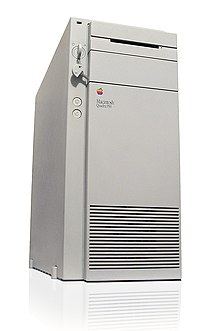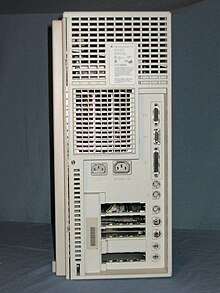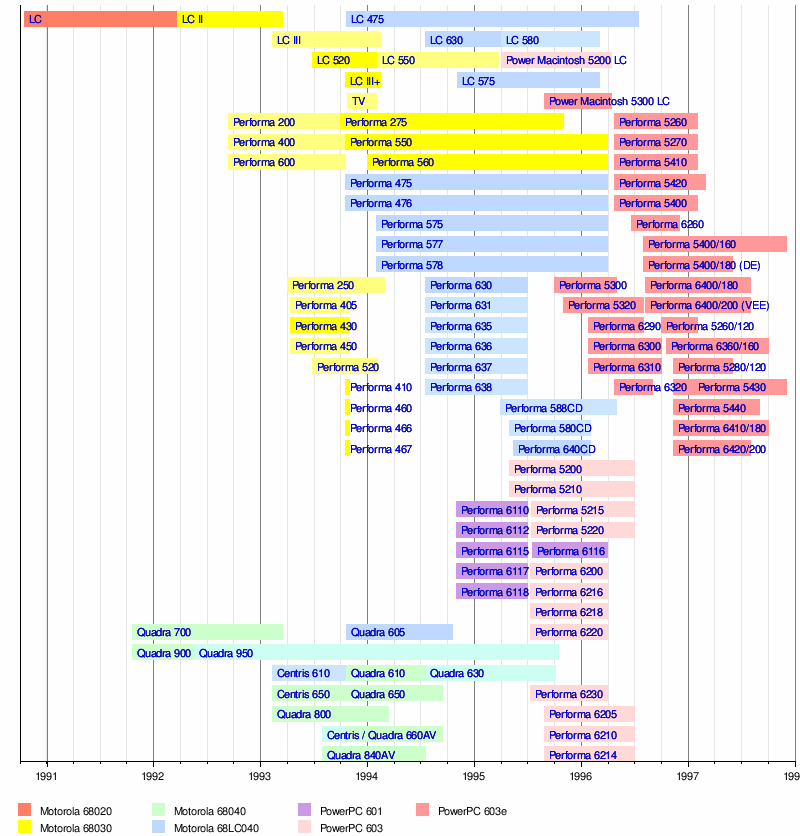 A Macintosh Quadra 950 | |
| Also known as | "Amazon"[1] |
|---|---|
| Developer | Apple Computer |
| Product family | Macintosh Quadra, Workgroup Server |
| Release date | March 18, 1992 |
| Introductory price | US$7,200 (equivalent to $15,630 in 2023) |
| Discontinued | October 14, 1995 |
| Operating system | System 7.0.1-Mac OS 8.1, or with PowerPC upgrade, Mac OS 9.1; A/UX 3.0 |
| CPU | Motorola 68040 @ 33 MHz |
| Memory | 4 MB, expandable to 256 MB (80 ns 30-pin SIMM) |
| Dimensions | Height: 18.6 in (47.25 cm) Width: 8.9 in (22.6 cm) Depth: 20.6 in (52.32 cm) |
| Mass | 36.8 pounds (16.7 kg) |
| Predecessor | Macintosh Quadra 900 |
| Successor | Power Macintosh 9500 Workgroup Server 9150 |
The Macintosh Quadra 950 (also sold with additional software as the Workgroup Server 95) is a personal computer designed, manufactured and sold by Apple Computer from March 1992 to October 1995. It replaced the Quadra 900 that was introduced several months earlier, increasing the CPU clock rate of its 68040 CPU from 25 MHz to 33 MHz, and improving the graphics support.[2] The two computers were otherwise identical, including the price. With a Macintosh Processor Upgrade Card installed, this computer is known as the Power Macintosh 950.
In 1993, the 950 was overtaken in performance by the less expensive Quadra 800 and 840AV. The newer Quadras had the addition of interleaved RAM, as well as an enhanced video system and SCSI bus. However, their more compact (mini-tower) case offered less expansion capability, so the 950 (due to its mid-tower case allowing 6 slots to be supported) was kept in continued production for the server market, outliving the 800 and 840AV. Also, the Quadra 800 was not capable of operating at 24-bit color, regardless of the amount of VRAM installed or the use of an external video card, while the Quadra 900 and 950 were capable of 24-bit color.[3]
The Quadra 950 was replaced by the PowerPC-based Power Macintosh 9500 in May 1995, with sales continuing until October.[4] It was the last Macintosh Quadra sold by Apple, and one of the last 68k models to be discontinued, due to its high RAM capacity and large number of NuBus slots. The Workgroup Server 95 was succeeded by the Workgroup Server 9150.

The logic board has five NuBus slots and a Processor Direct Slot, but due to the positioning of the PDS it is not possible to use one of the NuBus slots when a PDS card is installed.[2] The NuBus-90 standard is partially supported, allowing for cards to run at 20 MHz, and two of the slots provide 25 watts of power instead of the usual 15 watts.
The logic board has 1 MB of on-board video RAM, with 4 SIMM slots that allow for upgrading to 2 MB.[1]
The 950 includes a key to limit access to various subsystems depending on the computer's use environment. The key switch has three positions labelled OFF, ON and SECURE. The OFF position immediately cuts the power and prevents the computer from being powered on. The ON position allows the computer to operate normally. The SECURE position is intended for use as a server – power is always applied in this position. If the computer loses power, it immediately starts up when power is restored. Also, this position disables the keyboard, mouse and floppy disk drive.[5]
The Workgroup Server 95 models include the "Workgroup Server PDS Card", which provides three capabilities: Two SCSI controllers with two internal SCSI connectors (plus one external connector); a DMS SCSI control chip that reduces I/O load on the main CPU; and 128 KB of SRAM which is used as an L2 cache. There are three additional slots that provide the ability further expand the L2 cache to 512 KB.[6]
The Quadra 950 was announced on March 18, with dealers receiving machines around May 18.
Introduced May 18, 1992:
Introduced March 22, 1993:
AnimEigo upgraded their subtitling hardware to this model during the mid-1990s.
| Timeline of Macintosh Centris, LC, Performa, and Quadra models, colored by CPU type |
|---|
 |
| Timeline of Macintosh servers |
|---|
 |